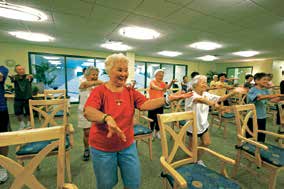 Balance. It’s something everyone takes for granted without a second thought about how crucial it is to daily living. However, it’s wise not to underestimate the importance of having good balance, especially in our senior years.
Balance. It’s something everyone takes for granted without a second thought about how crucial it is to daily living. However, it’s wise not to underestimate the importance of having good balance, especially in our senior years.
In addition to an increased risk of falls, poor balance and mobility can limit daily living activities and participation in leisure-time activities. Thus, it is essential to incorporate balancebuilding exercises into physical activity programs. Equally as important is a proper training progression to not only maintain or improve balance, but to ensure safety while practicing these exercises.Below is an outline of the components of a properly progressive balance training program.
Balance training exercises should start with placing the feet in a series of positions that gradually reduce the base of support, holding each stance for 10 to 30 seconds. These exercises provide subtle changes in balance, similar to those experienced in everyday life, allowing your body to learn how to respond appropriately so balance is maintained while standing still:
- Feet together as close as possible
- Semi-tandem (one foot ahead of the other as if taking a step)
- Full tandem (heel of one foot directly in front of the toes of the other foot)
- Standing on one foot
Gradually, introduce additional exercises that do the following: - Add dynamic movements to react to disturbances and changes in balance (leaning or stepping in different directions, lateral and forward reaching, picking up an object from the floor and tandem walking)
- Reduce visual input by closing the eyes or dimming the lights
- Challenge the vestibular system by moving the head from side to side
- Challenge the somatosensory system by standing on foam pads or another type of unsteady surface
Another important progressive component is the modification of the use of hand support.
General guidelines for a proper progression of hand support include: - Holding onto a chair with both hands
- Holding on to the chair with only one hand
- Using just one finger to balance
- Moving both hands free of the chair, but keeping them nearby — just in case
The key to balance exercises is to challenge yourself within your personal comfort zone. Progressing too rapidly can actually contribute to a fall. Many seniors perform these exercises with the assistance of wellness trainers as spotters. The spotter’s role is to stand by to steady participants, ensuring they do not fall, a necessary component of safety and effectiveness allowing seniors to challenge themselves and improve to more advanced types of exercises.


Leave a Reply